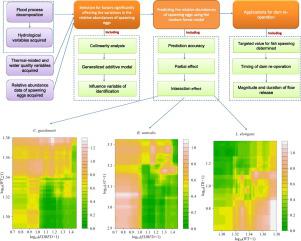Science of the Total Environment ( IF 8.2 ) Pub Date : 2021-05-10 , DOI: 10.1016/j.scitotenv.2021.147618 Zhi Yang , Qiguang Zhu , Jun Cao , Yao Jin , Na Zhao , Wei Xu , Hong Liu , Huiyuan Tang , Ye Qiao , Xiaojuan Chen

|
The construction of dams worldwide has substantially altered natural flow and thermal regimes, leading to profound influences on fish spawning. Environmental flow (EFlow) assessments provide information on the links between river flow and river health and are a useful technique for specifically restoring species' life-history requirements. A full understanding of the abiotic–biotic relationships coupled with information on hydrological events and ecological processes is a vital step for acquiring explicit water management options. However, the incorporation of concurrent and antecedent flow, thermal parameters, and other water quality information, particularly their complex interaction effects, into the prediction of the relationships between fish spawning and abiotic factors is poorly studied. The present study proposes a hierarchical modeling framework that accounts for the different concurrent and antecedent habitat factors and the interaction effects between factors to predict the spawning intensities of three important endemic fish species (which spawn drifting eggs) collected from the upper Yangtze River, China. Our results show that 1) the abiotic factors significantly affecting fish spawning vary with species, and these factors are intricately linked to species-specific ecology; 2) the water transparency during spawning and the accumulated temperature before spawning are important predictors of the spawning intensity of some fish species, while the effective duration of rising flow discharge before spawning plays a consistently important role in affecting the spawning intensity of all three fish species; and 3) there are explicit interaction effects, mainly between the hydrological and thermal variables, on fish spawning intensity. The present study suggests that investigation of the relationships between fish spawning and abiotic factors should not only analyze individual species but should also fully consider the accumulated temperature and effective duration of flow discharge rising before spawning, as well as the interaction effects between habitat factors.











































 京公网安备 11010802027423号
京公网安备 11010802027423号